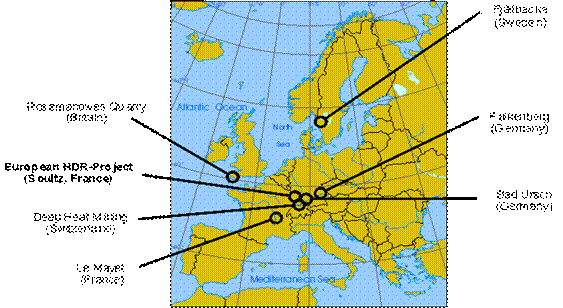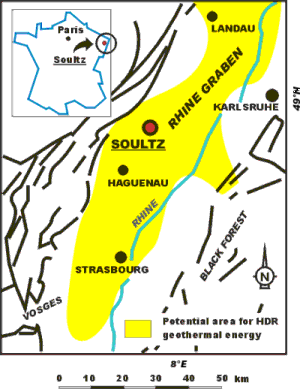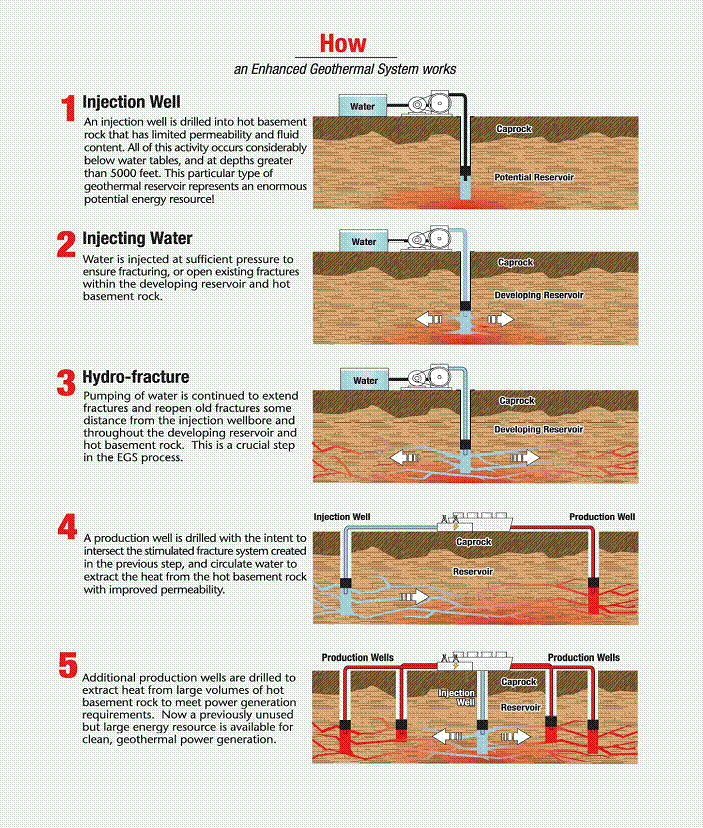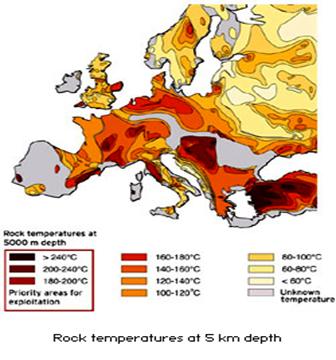Geology and Natural Heritage of the Long Valley Caldera
Pushing the Envelope of Geothermal Power to Prepare for the Next Generation
Brooks Proctor
We live in a world of computer chips and gas guzzling sport utility vehicles. Ironically, our world is standing on the thin ice of fossil fuels that are rapidly being depleted. Geothermal energy is a blessing for countries that have access to it and can use it in a cost-effective way. But there are few countries that are as lucky as Iceland , for example. They can supply their country with power because of where it's geologically located. Geothermal energy is not the answer to solving the fossil fuel problem. Yet, it has the potential for making large energy contributions for the planet with the development of new technology.
A geothermal power plant is not a recent development. The first geothermal power plant was built in 1904 at Larderello , Italy (Microsoft Encarta, “Geothermal Energy”). It is still in production today. The first nuclear chain reaction was produced by Enrico Fermi in 1942 (Microsoft Encarta, “Nuclear Energy”). Hydroelectric power plants did not become influential in the United States until the 1920's (Microsoft Encarta, “Water Power”). The idea of harnessing the earth's heat (for generating electricity) has been around for over a hundred years but there is not a plant in every state or country or even half the countries on the globe. Why not? Geothermal power is very clean; it has little to no emissions (depending on the type of plant) and it has very few by-products. The catch is, for geothermal power generation to be feasible a rare set of geological circumstance has to happen. Research and testing is currently being done with Hot-Dry-Rock (HDR) and Enhanced Geothermal Systems (EGS) technology to expand the range of geothermal power and possibly utilize the unlimited supply of heat energy deep within the earth.
Conventional geothermal applications (except for geothermal heat pumps) require a rare geological situation, a combination of water, heat, permeability and economically accessible depth (europa.eu.int). This uncommon situation is first limited by a source of heat, usually, a magma environment. If a country is not close to a magma environment which produces a high geothermal gradient near the surface then it would not be intelligent to build a geothermal power plant. Let's say the hypothetical country did have very high temperatures accessible below it. It would still have nothing to offer a geothermal power plant. This area would be called a hot dry rock environment. It is characterized by high temperatures, solid rock with little to no permeability and no available water (Duffield and Sass 22). Geothermal plants need a hydrothermal system (water) to extract heat from the earth. The key is “available” which refers to water and steam in rocks that can be utilized at the earth's surface (Duffield and Sass 10). Availability goes hand-in-hand with porosity and permeability. For a given area and temperature, the greater the permeability and porosity of the rock in a hydrothermal system, the greater its production of available water which means more energy yield (Duffield and Sass 10). Currently, the hydrothermal environment is the only commercially exploitable form of geothermal energy used for generating electricity (Duffield and Sass 10). And yet, it is all dependent on depth. Exploitable hydrothermal systems with temperatures of around 250 degrees Celsius can be located at depths from one to several kilometers, depending on local geothermal gradient and upward flow rates (Duffield and Sass 10). For maximum energy extraction, the challenge is to find geothermal environments of high temperatures at shallow depths. With current technology the economic drilling range is about four kilometers or less (Duffield and Sass 10). To complicate things more electrical power generation is only achieved if the hydrothermal system temperature is greater than 100 degrees Celsius, realistically greater that 150 degrees Celsius (Duffield and Sass 11). Casa Diablo binary-cycle geothermal power plant receives 170 degrees Celsius water from 200 meter wells (Duffield and Sass 16). Finding the right spot for a geothermal power plant is very difficult because of the many complicating factors. All of these factors put together relates to the few geothermal power plants world wide.
Enhanced geothermal systems (EGS) and Hot Dry Rock (HDR) projects are tapping into the energy from the earth in areas once considered uneconomical (Duffield and Sass 24). The first HDR experiment was conducted by Los Alamos National Laboratory on the western margin of the Valles Caldera in New Mexico (Duffield and Sass 22). A small hydrothermal system was created by pumping pressurized water down a borehole (Duffield and Sass 22). The water fractured the surrounding rock. The fractures allowed water to flow through the hot rock to an extraction well creating a loop that continued for nearly 20 years (Duffield and Sass 22). The project was later deemed unprofitable and stopped (Duffield and Sass 22). The main problem was high pressure was needed to maintain the slightest amount of circulation (Duffield and Sass 22). The knowledge gained form the experiment is being used in similar enhanced geothermal systems projects. The difference between HDR and EGS is EGS manipulates a hot area that has or had some natural permeability (Duffield and Sass 22). It tries to expand or enhance, for example, an old hydrothermal system that is presently dry or a fault system that if connected right could provide large flow rates (europa.eu.int). HDR projects are done in areas with basically no permeability (Duffield and Sass 22). The main idea is to create a path for water to cycle in a hot area with either little or no permeability and use the heat energy.
EGS has many advantages other than creating a self sustained generating unit in a HDR environment. EGS can be used to expand the range of commercially productive areas (Duffield and Sass 24). Surrounding many existing geothermal plants are areas zoned uneconomical. These areas are targets for enhancement because they are close to existing facilities and less money would have to be spent to develop the energy (Duffield and Sass 24). This will increase plant size and output (Duffield and Sass 24). There are many hydrothermal systems that have been found and considered unprofitable because of poor permeability (Duffield and Sass 24). These sites if enhanced could be developed at a lower price because a hydrothermal system is already in place (Duffield and Sass 24). EGS can also be used to extend the productivity and longevity of existing geothermal operations by precisely connecting fracture systems to increase flow rates and to add water at strategic locations (Duffield and Sass 24). EGS technology combines hydraulic fracturing, fault and fracture analysis, directional drilling to intersect fractures and injection of wastewater or groundwater to replenish lost pressure (Duffield and Sass 24). All those measures were used at The Geysers steam field in California to increase the amount of steam available to produce electricity (DOE 4). Treated waste water was pumped down into strategic areas (DOE 4). In addition to increasing lost steam pressure levels EGS gave the nearby communities a safe method for disposing of their waste water (DOE 4). HDR and EGS technology is currently helping countries in Europe combine to locate clean power that will benefit them in the future. One such project is in Soultz sous Forets , France (soultz.net).
The Soultz project is part of a larger European Union objective to ensure a reliable energy supply based on Renewable Energy Sources. It is realistic to predict a situation where HDR/EGS technologies could allow significant levels of electricity generation in many countries that are not considered geothermal. Since 1987 several national HDR research programs have been integrated into one European program at Soultz-sous-Forets , France . The partners include Italy , France , Switzerland , Germany and the UK . The research has been done by national teams with funding from their mother countries. An interested group of private companies has also participated in the project since 1992. In 1998 they formed the European Economic Interest Group (EEIG) to play a more active role in the work. In April 2001 the EEIG took over direction, co-ordination and management from the original European Commission (EC). The goal is to develop techniques to circulate water in a closed loop system between two or more boreholes through a constructed fracture system. The system is designed to provide a surface area of several square kilometers to transfer heat. A test was carried out in 1997 that showed it was possible to circulate 25 l/s (liters per second) between two wells at a depth of 3000-3500 meters and with well separation of about 450 meters. The test lasted for four months and showed low resistance to flow and zero water loss. But, temperatures were not high enough for electrical power generation. The funding agencies wanted temperatures to be reached for electricity generation, which they felt was around 200 degrees Celsius. One of the wells was deepened to 5000 meters. In 1998/9 202 degree Celsius was reached at 5000 meters. The present and future stages of the project, involves drilling two more 5000 meter wells. Then, fracture the intervening rock and achieve water flow between wells at rates of up to 100 l/s. If this is successful a pilot plant will be built with four 1.5 megawatt generating units. Eventually an industrial plant with more wells will be constructed with a capacity of 20-25 megawatts (europa.eu.int).
It's important to understand that HDR/EGS technology is still under development. Major problems include drilling and fracturing of deep crystalline rocks and achieving high sustained circulation rates. The benefits are potentially high, but presently the costs are very high. Part of the reason five countries are working on the Soultz project is because it is costing a lot of money, more than one country wants to take on alone. One borehole 4-5000 meters deep can cost several million euros (1euro =1.21 dollars). In addition, years of successful operation will be required before utility companies could be expected to develop confidence in the system. New cost-effective drilling needs to be developed, as well as improved real-time characterization and monitoring. Other barriers include lack of public awareness, an inappropriate regulatory environment, and competition with conventional energy sources (europa.eu.int).
The big question is why should anyone care about hot dry rocks and EGS technology? A better question would be what is HDR and EGS technology doing for geothermal power? The answer is EGS is going to make geothermal power a house hold name and a world wide energy producer. It is going to expand geothermal power form a small scale energy contributor that is convenient for a few countries to a large world wide contributor of power. The Europeans are not drilling holes for fun. They have realized we (the world's inhabitants) need to find ways to make electricity that doesn't involve burning fossil fuels. Anywhere in the world if you drill down deep enough there will be temperatures hot enough to generate electricity. That is basically the main idea behind HDR and EGS technology. If projects like Soultz can develop cost-effective ways to mine heat from deep within the earth, then the world is one step closer to conserving the fossil fuels remaining. Ideally, HDR/EGS would benefit countries deficient in fossil fuels. Those countries could start producing electricity from thermal energy and spend less money importing coal and oil. This in theory would mean more money to benefit the inhabitants. This applies to all countries as well. The potential for geothermal power is great but factors such as time, money and politics will determine if geothermal power will be used to help supply the world with power through the post fossil fuel era.
HDR Projects in Europe
(soultz.net)
The European HDR-project is situated in Soultz-sous-Forêts , France , at the western border of the Rhine Graben.
(soultz.net)
( U.S. Department of Energy. Enhanced Geothermal Systems )
( www.soultz.net )Works Cited
Duffield, Wendell and John H. Sass. Geothermal Energy-Clean Power From the Earth's Heat . U.S. Geological Survey, Reston, Virginia : 2003.
“Comparison of Main HDR-Reservoirs in the World.” Soultz.net . 8 Jun. 2005. European Deep Geothermal Energy Programme. 1987 www.soultz.net/
“Geothermal Energy.” Microsoft Encarta Encyclopedia Standard 2004 . CD-ROM. 2004 ed. Microsoft, 2004.
“Geothermics.” Microsoft Encarta Encyclopedia Standard 2004 . CD-ROM. 2004 ed. Microsoft, 2004.
“HDR-Projects in Europe .” Soultz.net . 8 Jun. 2005. European Deep Geothermal Energy Programme. 1987 www.soultz.net/
“Nuclear Energy.” Microsoft Encarta Encyclopedia Standard 2004 . CD-ROM. 2004 ed. Microsoft, 2004.
“Research and Development Needed for Enhanced Geothermal Systems.” Europa.eu.int . European Communities, 1995-2005 http://europa.eu.int/comm/research/energy/nn/nn_rt/nn_rt_geo/article_1135_en.htm >
“Rock Temperatures at 5 Km Depth.” Europa.eu.int . European Communities, 1995-2005. http://europa.eu.int/comm/research/energy/nn/nn_rt/nn_rt_geo/article_1134_en.htm >
“Soultz: What has been done –Important Milestones.” Soultz.net . 8 Jun. 2005. European Deep Geothermal Energy Programme. 1987 www.soultz.net/
“The Site.” Soultz.net . 8 Jun. 2005. European Deep Geothermal Energy Programme. 1987 www.soultz.net/
U.S. Department of Energy. Geothermal Technologies Program. Enhanced Geothermal Systems . Washington , DC : August 2004.
“What are the advantages of EGS technology?.” Europa.eu.int . European Communities, 1995-2005. < http://europa.eu.int/comm/research/energy/nn/nn_rt/nn_rt_geo/article_1134_en.htm >
“What are the non-technical barriers to be overcome?.” Europa.eu.int . European Communities, 1995-2005. < http://europa.eu.int/comm/research/energy/nn/nn_rt/nn_rt_geo/article_1135_en.htm >
“What is the future potential of EGS technology?.” Europa.eu.int . European Communities, 1995-2005. < http://europa.eu.int/comm/research/energy/nn/nn_rt/nn_rt_geo/article_1134_en.htm >
“What research is necessary for EGS?.” Europa.eu.int . European Communities, 1995-2005.< http://europa.eu.int/comm/research/energy/nn/nn_rt/nn_rt_geo/article_1135_en.htm >
“What spedifically does it offer the EU?.” Europa.eu.int . European Communities, 1995-2005.< http://europa.eu.int/comm/research/energy/nn/nn_rt/nn_rt_geo/article_1134_en.htm >
“Why aren't EGS systems in regular use yet?.” Europa.eu.int . European Communities, 1995-2005. <http://europa.eu.int/comm/research/energy/nn/nn_rt/nn_rt_geo/article_1135_en.htm>
“Why do we need research?.” Europa.eu.int . European Communities, 1995-2005.< http://europa.eu.int/comm/research/energy/nn/nn_rt/nn_rt_geo/article_1134_en.htm >



